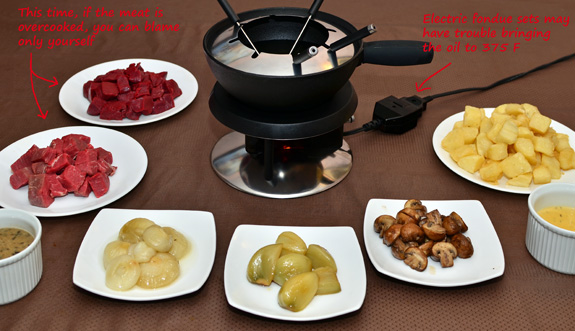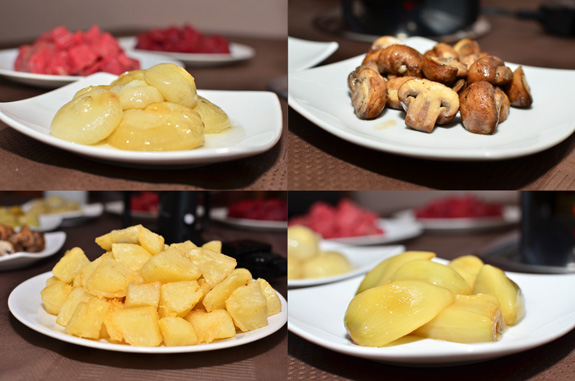For as long as I’ve been reviewing restaurants, I’ve been complaining about the mediocrity of their Beef Stroganoff: “the filet mignon was chewy, cooked beyond well done”, “another example of how to transform an expensive and tender cut of beef (the tenderloin) into shoe sole”, “the overabundant mushroom sauce had the gooey texture of something made with a store-bought mix”, “the leftovers sit unclaimed in our fridge”. While some restaurants have fared a bit better (here and here), I felt like I should give my own version to justify my criticisms and prove that yes, you can make a good Beef Stroganoff, and it’s not even that hard.
Let’s start with a short history lesson. The etymology of the dish is presumably connected to some member of the Stroganoff family (exactly which one isn’t clear), which was dominant for more than five centuries in the Russian aristocracy and owned a vast palace in Saint-Petersburg. However, dishes of braised meats finished with sour cream were already fairly typical of medieval Russian cookery, and also in neighboring regions. In The Cuisine of Hungary, George Lang mentions several recipes of tokany, a ragout where the meat is cut into strips:
“One of the most interesting versions of tokany is the ancient dish of sour cream vetrece (savanyu vetrece), which was already mentioned as a part of the dinners of King Matthias in the fifteenth century. In this type of ragout, beef is cooked with smoked bacon, garlic and black pepper; later bay leaves, mustard, lemon juice, vinegar, sugar and grated lemon rind are added, and finally sour cream. The only flavors lost over the centuries are mace, ginger and saffron. In the dining rooms of the Transylvanian gentry, paper-thin slices of peeled lemon were served on top of this more sweet than sour dish.”
The first known recipe for “Beef Stroganov with mustard”, appeared in Elena Molokhovets’ A Gift to Young Housewives in 1861. The simple recipe contained neither onions nor mushrooms, beef cubes were sautéed, sauced with prepared mustard and bouillon, and finished with a small amount of sour cream. An early 20th century recipe by Pelageya Aleksandrova-Ignateva added chopped onions and tomato paste to the sauce, and served the meat with crisp potato straws. Larousse Gastronomique has provided several versions over the years since then, including beef strips with various combinations of onions, mushrooms, white wine, mustard, tomato paste, cream, and parsley. The dish also became wildly popular in the U.S. in the sixties, the potatoes usually replaced with rice or noodles. Some versions in recent American cookbooks, such as James Peterson’s Meat: A Kitchen Education (2011), contain onions, mushrooms, sherry, and crème fraîche, but drop the mustard and tomato paste altogether.
As you can see, there is no single Beef Stroganoff, and for every ingredient in a given recipe, you can find another recipe that doesn’t use it. Even the beef can be replaced with chicken, tuna, or shrimp! So I thought it would be interesting to let the diners make their own. I provide 2 kinds of meat, 2 sauces, 4 kinds of vegetables, and each person can finish the dish in an oil-filled fondue pot as they see fit, just as in a fondue bourguignonne. This also solves the aforementioned Overcooked Meat Problem.
This is a pretty simple recipe. It might be time-consuming to prepare all the different elements, but one can always choose to prepare only half of them to save time.
Fried potatoes
Yields 4 servings
35 oz peeled potatoes
canola oil (for deep-frying)
- Fill a pot large enough to contain the potatoes with water mixed with 1% salt, and bring to a boil. Cut the potatoes into 1″ cubes. Add to the pot, return to a simmer, and cook over medium heat until the potatoes are just starting to break when you pick them out (you should start watching for this after about 15 minutes of simmering). Using a skimmer, transfer the fries to a cooling rack, let cool, then refrigerate until cold.
- Fill a deep-fryer with the canola oil, and bring to 250 F. Proceeding in batches if necessary, deep-fry the fries until they look dry and slightly colored. Don’t overfill; the potatoes tend to release a lot of water, which increases the liquid-level in the fryer. Transfer to a cooling rack and discard (or eat) the small broken potato pieces — there will be some, unavoidably. Let cool, then refrigerate until cold.
Onion and garlic confit
Yields 4 servings
8 cipollini onions, peeled
4 elephant garlic cloves, peeled
salt
2 thyme sprigs
about 10 oz olive oil
- Season the onions and garlic cloves with salt. Place in two separate saucepans, cover each with olive oil, add the thyme sprigs, and cook over very low heat, until completely tender — 1 hour for the onions, 30 minutes for the garlic. If you want to use less olive oil, you can cook the onions first, then reuse the same oil for the garlic.
- Let cool in the oil, then drain and reserve.
- You can keep the oil for a few days and use it for other recipes.
Sautéed mushrooms
Yields 4 servings
6 oz white mushrooms, cleaned and halved
1/2 oz olive oil (or oil from the onion confit above)
salt
black pepper, ground
- In a pan over hight heat, sauté the mushrooms in the olive oil. Season with salt and pepper, and cook until done, stirring regularly.
- Let cool and reserve.
Mustard Stroganoff sauce
Yields 4 servings
1/2 tsp caraway seeds
1/2 oz butter
2 oz white mushrooms, sliced
1 oz shallots, small dice
salt
pepper
1 pinch saffron
1 bouquet garni
0.7 oz cognac
4 oz white wine
8 oz beef stock
4 oz sour cream
0.15 oz brown sugar
0.5 oz Dijon mustard
- In a saucepan over medium heat, toast the caraway seeds for 30 seconds. Add the butter, and sauté the mushrooms and shallots until soft. Season with salt and pepper, then add the saffron, bouquet garni, cognac, and white wine, and reduce by half.
- Add the beef stock, and simmer for 5 minutes. Add the sour cream, brown sugar, and half of the mustard. and reduce until the sauce coats the back of a spoon.
- Pass through a chinois, and reserve.
- Before serving, reheat and stir in the remaining mustard.
Wild mushroom Stroganoff sauce
Yields 4 servings
2 oz onion
1 oz butter
4 oz morels or black trumpet mushrooms, cleaned and rinsed
0.5 oz cognac
3 oz riesling
12 oz beef stock
2 oz cream
1 egg yolk
- In a saucepan over medium heat, sauté the onion in the butter until soft.
- Thinly slice the mushrooms, then add to the saucepan, and cook for a couple minutes.
- Add the cognac and riesling, and reduce by half.
- Add the beef stock, and reduce to 1/3.
- Mix the cream and egg yolk in a bowl. Slowly pour over the sauce while mixing constantly. Return to the saucepan, and cook over low heat for a couple minutes until thickened, stirring regularly. Reserve.
- Before serving, reheat the sauce over low heat, without boiling.
Fondue meat
Yields 4 servings
24 oz beef and/or venison tenderloin
- Cut the meat into 0.5″ x 0.75″ pieces, and reserve.
- Take out of the fridge 30 minutes before serving.
Service
canola oil (for deep-frying)
- Fill the fondue pot about half-way with canola oil. Heat the oil to 375 F (you can use your stove top).
- Place a piece of meat or vegetable on a fondue pick, and deep-fry until done. Top with sauce and enjoy!


